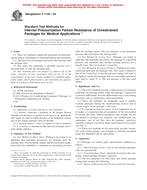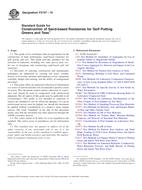1.1 This test method covers the techniques used to determine the wavelength of the photoluminescence peak and the mole percent phosphorus content of gallium arsenide phosphide, GaAs(1 x)Px.
1.2 Photoluminescence measurements indicate the composition only in the illuminated region and only within a very short distance from the surface, a distance limited by the penetration of the radiation and the diffusion length of the photo-generated carriers, as contrasted to X-ray measurements which sample a much deeper volume.
1.3 This test method is limited by the surface preparation procedure to application to epitaxial layers of the semiconductor grown in a vapor-phase reactor on a flat substrate. It is directly applicable to n-type GaAs(1x)Px with the wavelength, PL, of the photoluminescence peak in the range from 640 to 670 nm, corresponding to mole percent phosphorus in the range from 36 to 42 % ( x = 0.36 to 0.42). The calibration data provided for the determination of x from P L is applicable to material doped with tellurium or selenium at concentrations in the range from 1016 to 1018 atoms/cm³.
1.4 The principle of this test method is more broadly applicable. Other material preparation methods may require different surface treatments. Extension to other dopants, doping ranges or composition ranges requires further work to relate PL to the phosphorus content as determined by X-ray measurements of the precise dimensions of the unit cell upon which the calibration data are based. It is essential that calibration specimens have uniform composition in the volume sampled.
1.5 This test method is essentially nondestructive. It requires a light etching of the sample to be measured. The removal of a layer of material approximately 0.5 to 1.0 m in thickness is required. This etching does not degrade the specimen in that devices can still be fabricated from it.
1.6 This test method is applicable to process control in the preparation of materials and to materials acceptance.
1.7 This standard does not purport to address all of the safety concerns, if any, associated with its use. It is the responsibility of the user of this standard to establish appropriate safety and health practices and determine the applicability of regulatory limitations prior to use. Specific hazard statements are given in Section 7.
Product Details
- Published:
- 01/01/2002
- Number of Pages:
- 4
- File Size:
- 1 file , 54 KB


